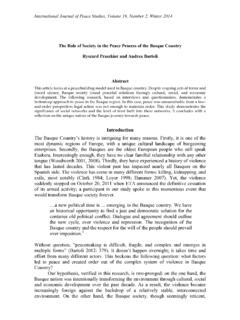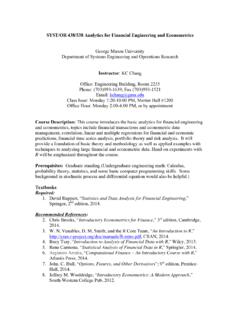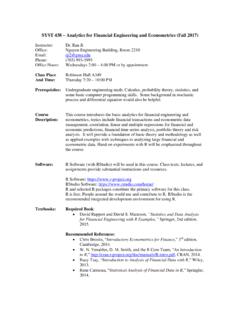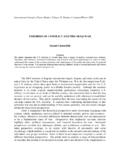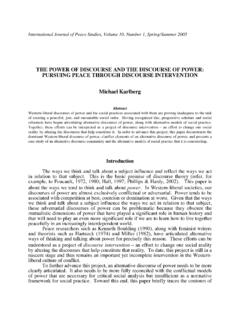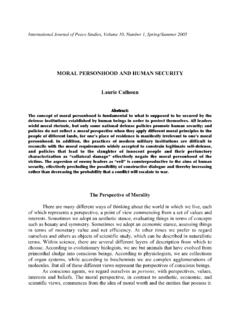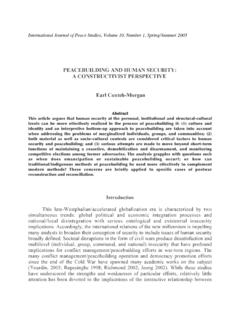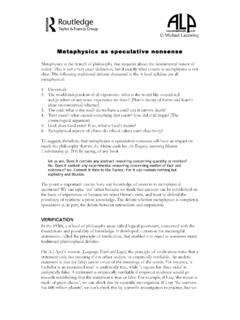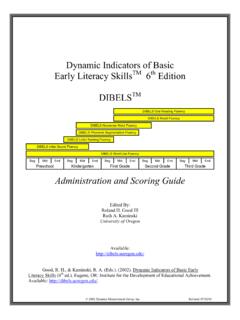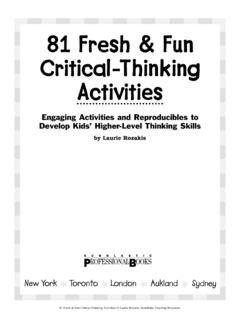Transcription of Making Phonological Sense out of Nonsense Poetry LAMM
1 Making Phonological Sense out of Nonsense Poetry JODI LAMM Abstract Poets like Carroll, Seuss, and others have defined the genre of Nonsense Poetry by Making an art out of combining neologisms with poetic form, and giving their readers a Sense that they know what is happening in a poem without having any idea what these new words mean alone. These poets must not only have knowledge about word rhymes and the rhythm of Poetry , but they must also have a Sense of what could phonologically constitute a word. An analysis of the neologisms contained in the Poetry of nine different works will reveal exactly what the poets are phonologically aware of, and to what extent these poets can manipulate Phonological constraints while maintaining the poetic form, and with it, some Sense of meaning in their Poetry .
2 My aim in this categorization is to find out how far a Nonsense poet can stretch the constraints on human language and still present a poem that reads easily for an English speaker. This tension between the sound and form of natural language and the creativity of neologisms comes through in the poems from which the data come. None of the Nonsense goes so far outside the constraints of English, or even human language, that it is rendered meaningless within the Poetry . 1. Introduction With one read through Lewis Carroll s (1995) The Jabberwocky, an English speaker is bound to notice two things: the poem seems to make Sense , yet there are words contained in it that they know have never appeared in the English language.
3 Poets like Carroll, Seuss, and others have defined the genre of Nonsense Poetry . They have made an art out of combining neologisms with poetic form and giving their readers a Sense that they know what is happening in a poem without having any idea what these new words mean alone. These poets must not only have knowledge about word rhymes and the rhythm of Poetry , but they must also have a Sense of what could phonologically constitute a word. An analysis of the neologisms contained in the Poetry of nine different works will reveal exactly what the poets are phonologically aware of, and to what extent these poets can manipulate Phonological constraints while maintaining the poetic form, and with it, some Sense of meaning in their Poetry .
4 Scope While the genre of Nonsense Poetry contains works without neologisms, I will be looking only at those poems with neologisms and natural English within the same poetic form. I will look only at the phonology of the neologisms: whether they conform to English and human universal segment constraints and how they conform to English syllable structure. I am interested not in the meaning the neologisms intend, but how they adhere to these Phonological principles. I am concerned with meaning only insofar as it may affect the pronunciation of a word. Essentially, I am interested in knowing what linguistic knowledge a poet attempting to create such Nonsense possesses and how his words will demonstrate that such knowledge is not actually Phonological Nonsense .
5 Jodi Lamm 2 Methodology In my search for Nonsense words I began with an anthology of the genre, and worked my way through poems containing any words that were clearly coined by the poet. If it did not look like a natural word of English, I considered it Nonsense . These words were checked against the Merriam Webster (2010) online dictionary to ensure neologistic status. I then categorized the words into non-violating of English segments or structure, one violation of English segments or structure, or a violation of human language segment or structure. My aim in this categorization is to find out how far a Nonsense poet can stretch the constraints on human language and still present a poem that reads easily for an English speaker.
6 2. Literature Review As one of the most well known examples of Nonsense Poetry , Lewis Carroll s (1995) The Jabberwocky not only pulls the reader into an alternate universe simply by the creation of new words, but it also challenges a reader to accept these new words as legitimate parts of speech well suited to the rhyme and meter of the poem. Like Alice, the readers are drawn through the looking-glass into a world where the natural order of the world has been disturbed, and they question the meaning of known words while looking for meaning in words they do not recognize.
7 It is precisely this tension between the real and the unreal that causes Nonsense Poetry to flourish. The combination of sounds may be unfamiliar, but the reader is able to make Sense out of them within both a poetic framework and a Phonological one. To what extent meaning is obscured is a matter of contention for some authors, but all agree that the strict adherence to pattern is what makes the poem maintain any Sense of meaning overall, and there is a definite limit to how nonsensical the words can be in English Nonsense Poetry . Holquist (1969) reports Elizabeth Sewell s opinion on Nonsense : It is a collection of words of events which in their arrangement do not fit into some recognized system (p.)
8 150). Overall, this is the effect which Nonsense Poetry produces, but we will see that the words themselves actually do fit into a system: English phonology. Holquist (1969) himself writes on Nonsense that, It is a closed field of language in which the meaning of any single unit is dependent on its relationship to the system of the other constituents (p. 150). Surely for these Nonsense poets, the neologisms depend on the surrounding architecture of the English language in the poem. For the Poetry critic, Nonsense Poetry makes any definite meaning of language difficult to grasp, but the rhyme and rhythm of the Poetry create an ideal setting for Nonsense words to blend in and thrive.
9 Flescher (1969) states that, The backbone of Nonsense must be a consciously regulated pattern (p. 128). There must be a more stable situation for Nonsense words in order to make any kind of meaning come through, and this setting consists of not only the form of Poetry , but also the natural sounds, grammar, and stress pattern of the original language. The poem, this controlled form of language, almost completely overtakes meaning for Shires (1988): Jabberwocky privileges form without regard for content; it privileges the metonymic over the metaphoric (p. 276).
10 To suit the theme of his story, Carroll uses strict form with Nonsense words to create tension between order and disorder. For both Flescher and Shires there is a theme of Making Phonological Sense out of Nonsense Poetry 3 lost identity in the Alice stories, and the Nonsense of The Jabberwocky and other poems I have included in analysis lend a voice to that theme by blurring the line between Sense and Nonsense . Although Imholz (1987) does not go into depth phonologically, in his article evaluating translations of the Jabberwocky, he notes that the Nonsense words of the English version are all pronounceable, and that it is important that they fit the pattern of sounds relative to the language in which they occur.

